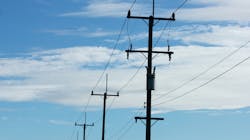An Unsung Workhorse in Utility Distribution Networks
Not long ago, I saw workers doing some sort of maintenance on wooden utility poles near my home. Upon inquiry, I learned the men were applying a life extension treatment to poles owned by the local telecommunications provider. Further research revealed a telecom company recently purchased most of the distribution poles formerly owned by the electric utility that provides service near a major Eastern city. While there are obviously many key components that make up electric and telecom distribution networks, the nearly ubiquitous distribution pole remains fundamental and strategic even in today’s digital world.
It is not a secret that electric and telecommunications utilities are increasingly looking to their utility pole assets to serve additional duties in support of broadband fiber networks and 5G infrastructure such as antenna systems. Some folks may recall FCC’s Connect America Fund implemented to provide voice and broadband services valued up to $2 billion to rural communities across America. Additionally, both electrics and communications companies are spending billions per year on smart grid and next generation telecom technologies which depend on pole mounted infrastructure.
The market research firm Lucintel offers a utility pole market research report that estimates the worldwide demand for electric utility poles alone will reach an estimated $53.3 billion by 2025 with a CAGR of 3% to 5% from 2020 to 2025. One aspect of that demand is the replacement of aging networks. Osmose raises a red flag regarding this very issue in a recent whitepaper, stating that the average age of wood poles in use is about 34 years and the average retirement age based on fitness for duty is slightly over 45 years.
According to Elaina Jackson with Pacific Wood Preserving Co., there are 160 to 180 million wood utility poles in service in the U.S. Osmose does some math in its whitepaper, concluding the replacement of all aging wood poles would be prohibitively expensive and potentially impossible from a resource availability standpoint. Nonetheless, focused action appears essential as we continue to rely on existing utility pole assets to operate and expand networks. It should come as no surprise, even to those of us divorced from day-today utility infrastructure issues, that there are multiple industries devoted to the inspection, evaluation, and maintenance of utility poles.
Utilities recognize that poles and related components account for a significant percentage of the investment value of distribution plant in-service. In our modern, litigious society, the proper maintenance and inspection of poles is critical for system reliability, resiliency, and legal protection. Utilities use inspections and resources such as the American Wood Protection Association’s (AWPA) decay hazard zone map to finetune the expected service life of pole assets based on climate and other factors. Further, utilities look to ANSI O5.1-2017 for information that defines the quality, dimensions, and basic engineering specifications recommended for new treated wood poles. The National Electric Safety Code (NESC) provides requirements for when wood structures must be replaced or rehabilitated.
While pole replacement is inevitable, robust inspection, maintenance and strengthening programs can significantly extend pole life and increase loading capacity for system modernization. Supplemental preservative treatments can be used to extend the decay/insect resistance in wood poles. Remedial groundline treatments such as application of preservative pastes/wrappings also aid in life extension. For damaged poles, restoration using trusses or other strengthening devices can extend life by 15 or more years in some cases; and pole upgrades can be accomplished with added strengthening for increased loads. In a study performed for Osmose, researchers found the average useful life of wood poles can be extended from 45 to 73 years with a comprehensive inspection and treatment program.
Utility pole life extension programs provide a viable means of spreading out pole replacements and simultaneously reducing long-term costs. However, at some point, the extend or replace analysis will say replace. Today, there are a dizzying array of pole composition choices including traditional wood, laminated, composite, steel and alloys, concrete, and polymers. While some of these materials are generally reserved for transmission or other unique service conditions, the decision is always a multi-faceted analysis that considers factors including loading requirements, environmental conditions such as soil, water level, air and below-ground corrosion parameters, resistivity and weather. Even the use of steel is not a “set it and forget it” proposition as explained in “Practical Transmission Pole Selection” (T&D World, Nov. 2019).
America’s aging distribution pole population has reached the point of requiring more frequent inspection, maintenance and increasingly, replacement. The iconic wooden utility pole may have material choice competition going forward, but evidence indicates distribution poles, which have served as critical components of utility networks since electric and telecom services began, will remain fundamental and strategic to these businesses for the foreseeable future.
About the Author
David Shadle
Grid Optimization Editor
Dave joined the T&D World team as the editor of the Grid Optimization Center of Excellence website in January 2016.
Dave is a power industry veteran with a history of leading environmental and development organizations, championing crucial projects, managing major acquisitions and implementing change. Dave is currently a principal at Power Advance, LLC, an independent consulting firm specializing in power project development, research and analysis, due diligence and valuation support. Dave is also a contributing consultant for Transmission & Distribution World. Prior to Power Advance, Dave held business and power project development positions with The Louis Berger Group, Iberdrola Renewables, FPL Energy and General Public Utilities. He is a graduate of Pennsylvania State University, the New Jersey Institute of Technology and Purdue University.
